Old English Grammar General characteristics
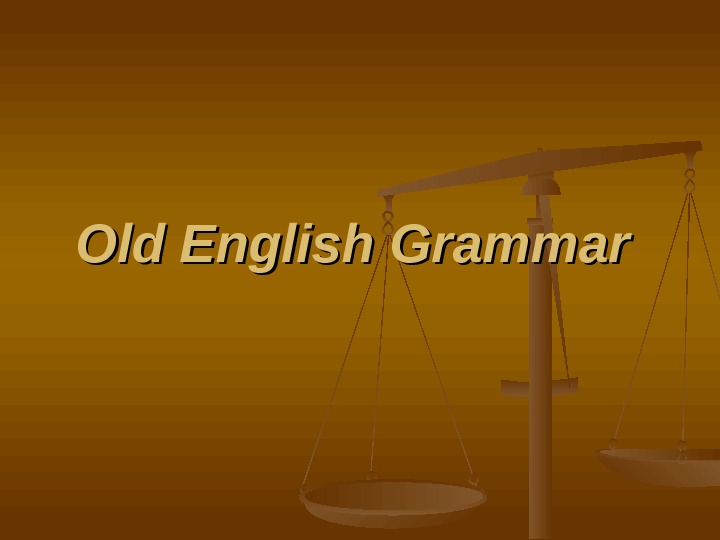
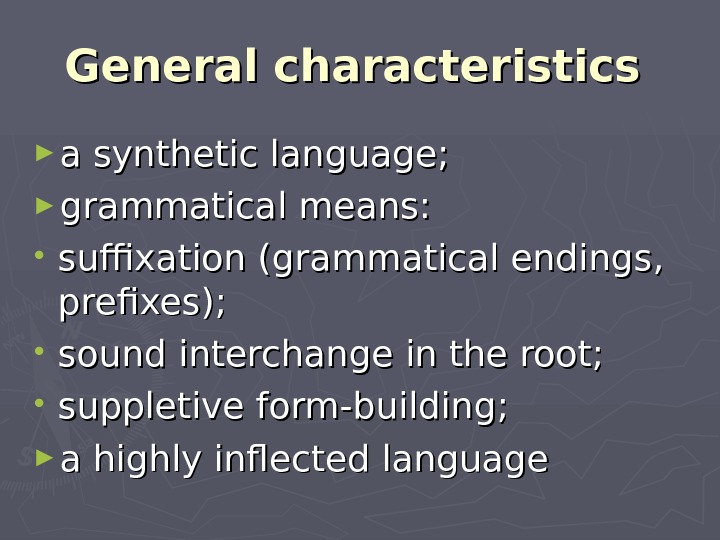
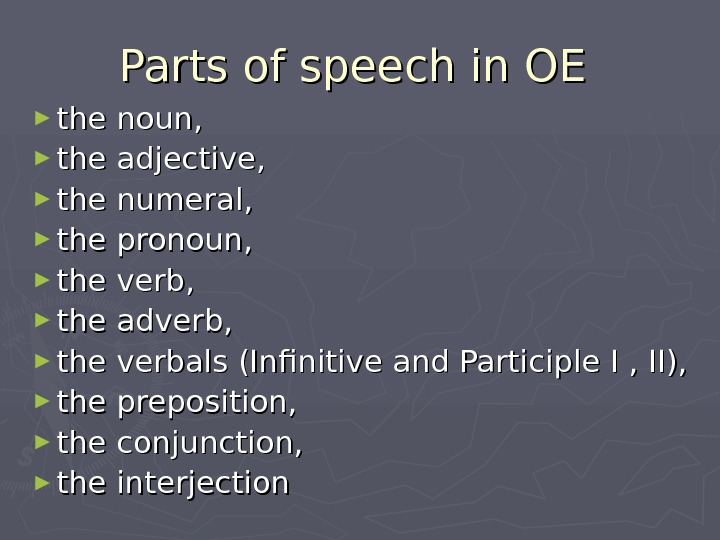
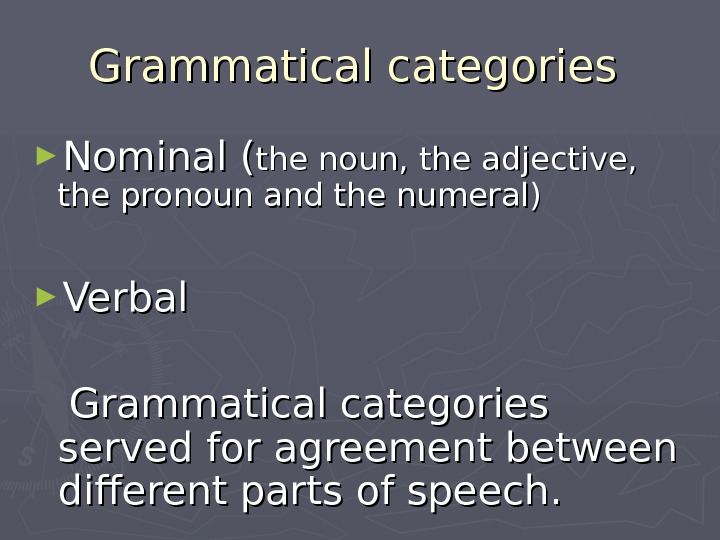
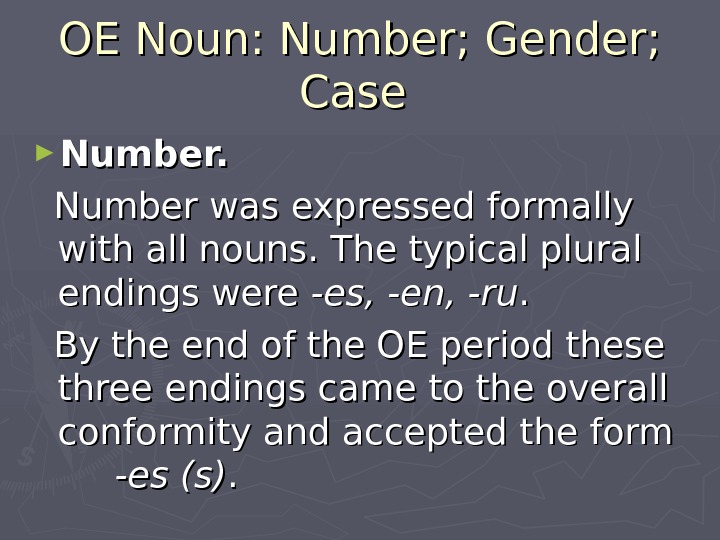
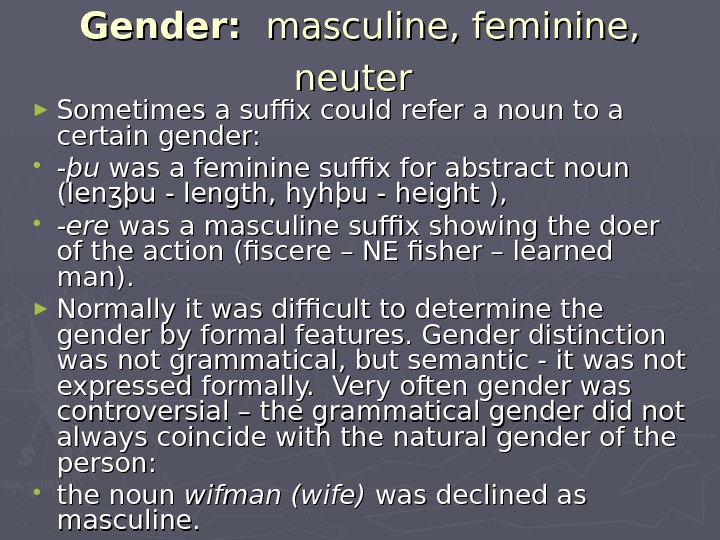
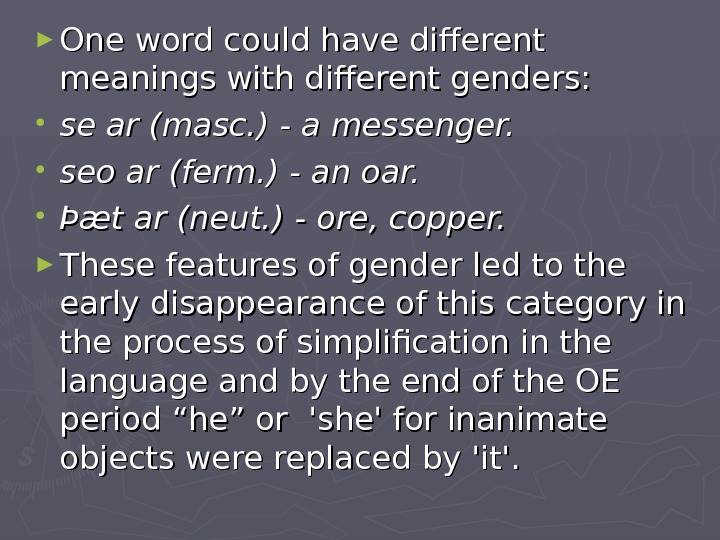
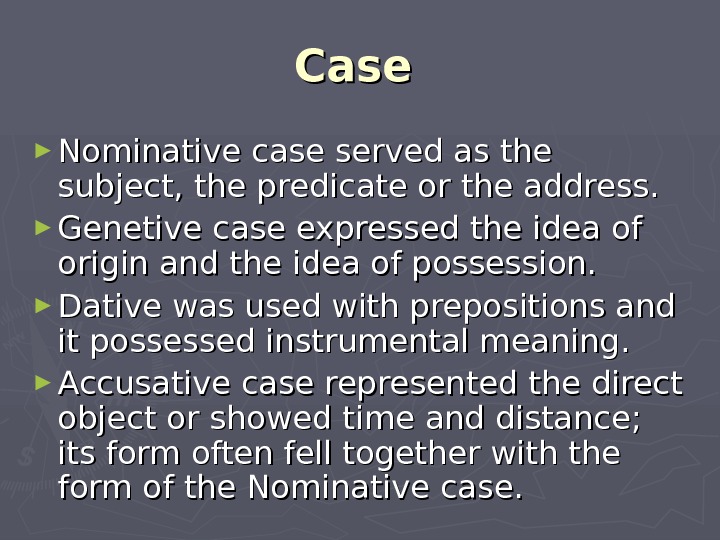
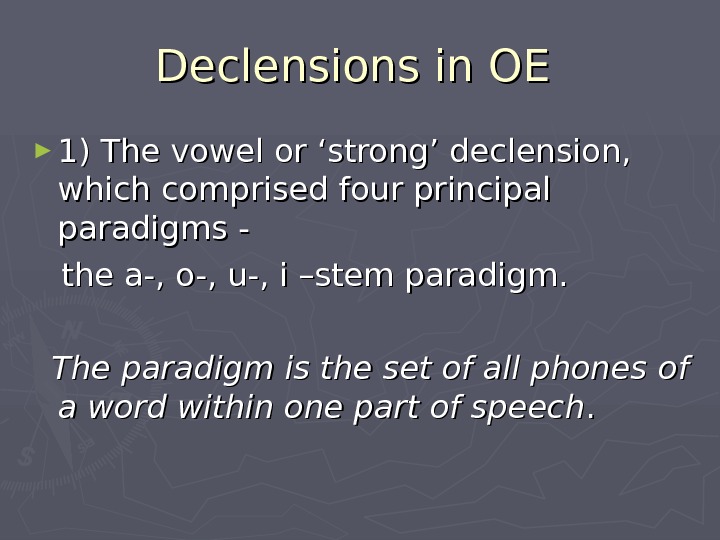
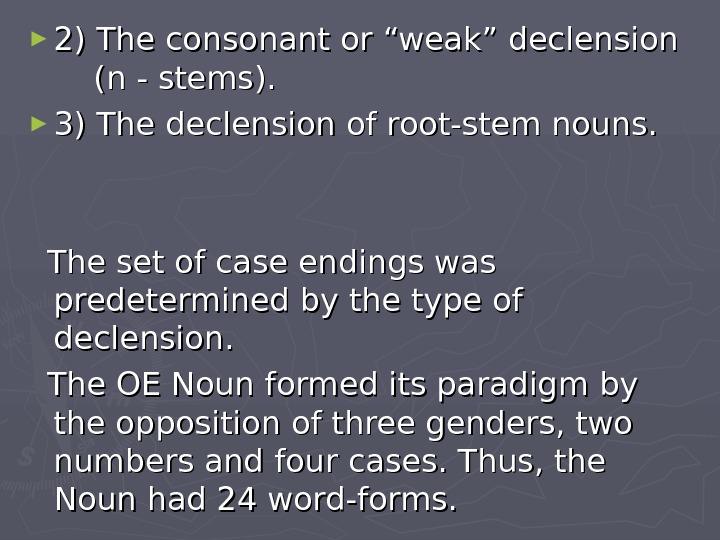
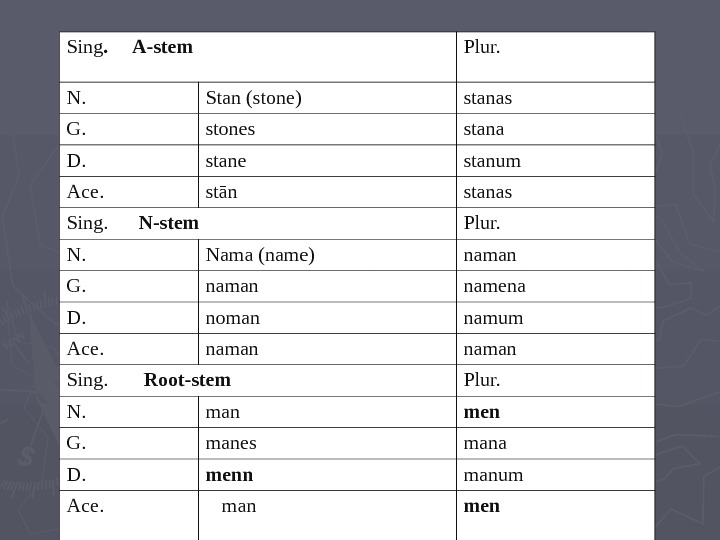
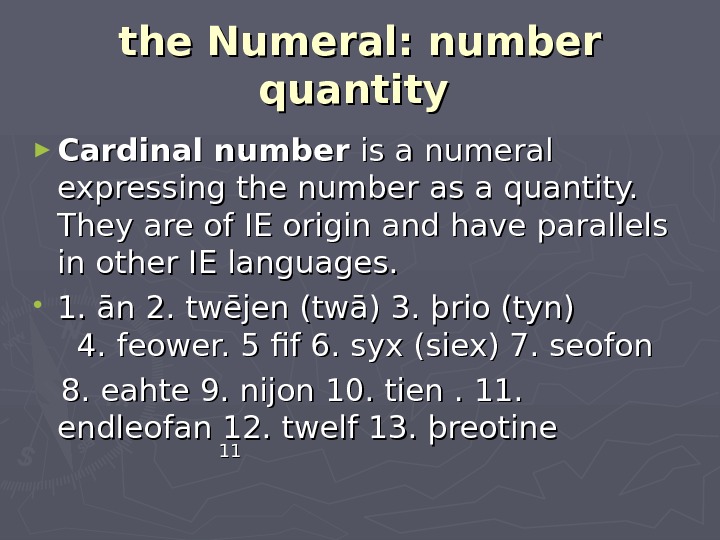
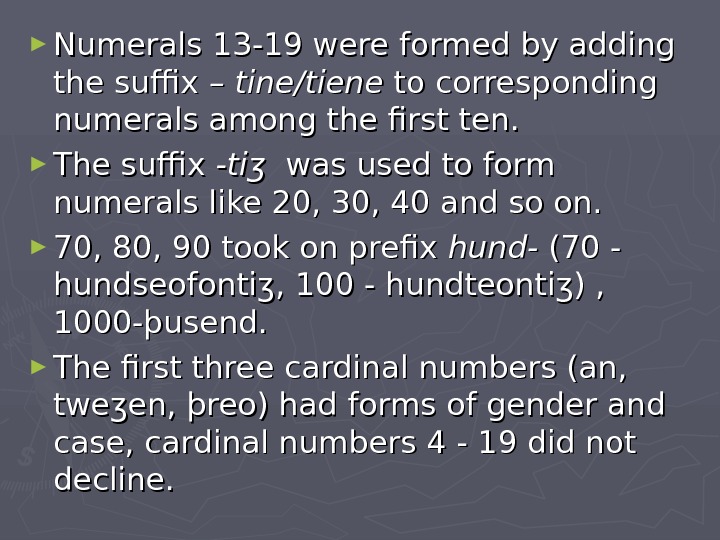
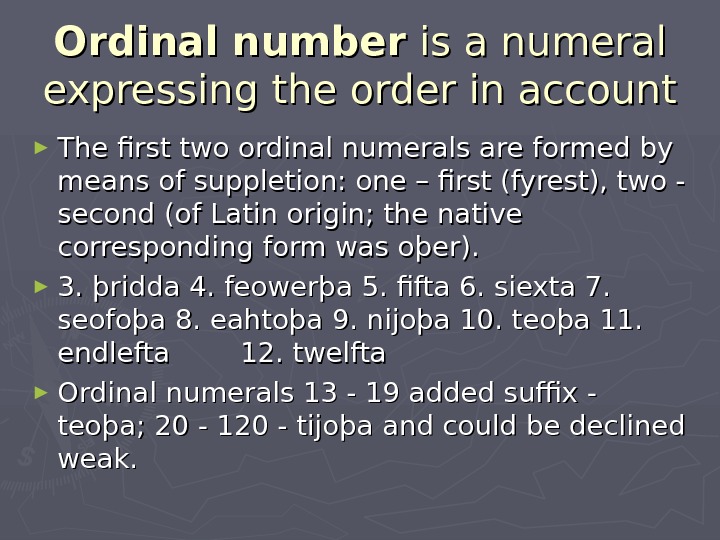
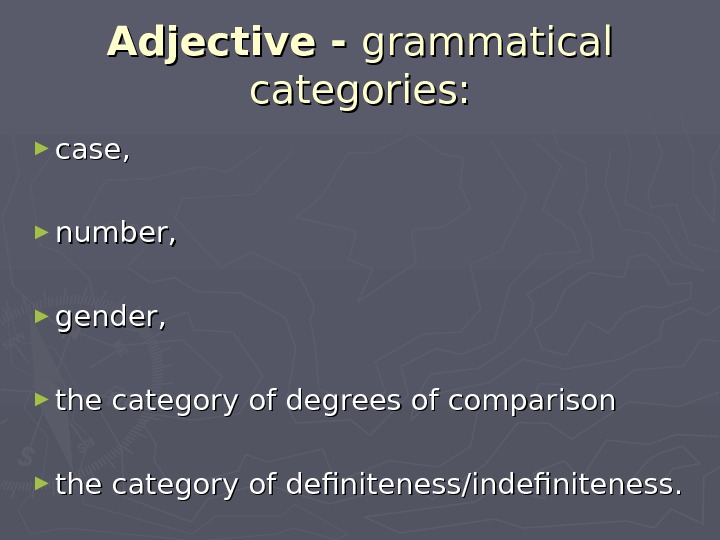

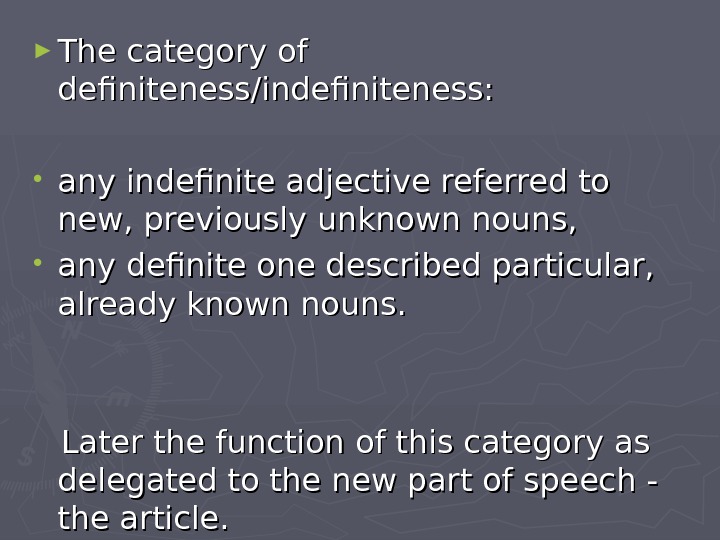

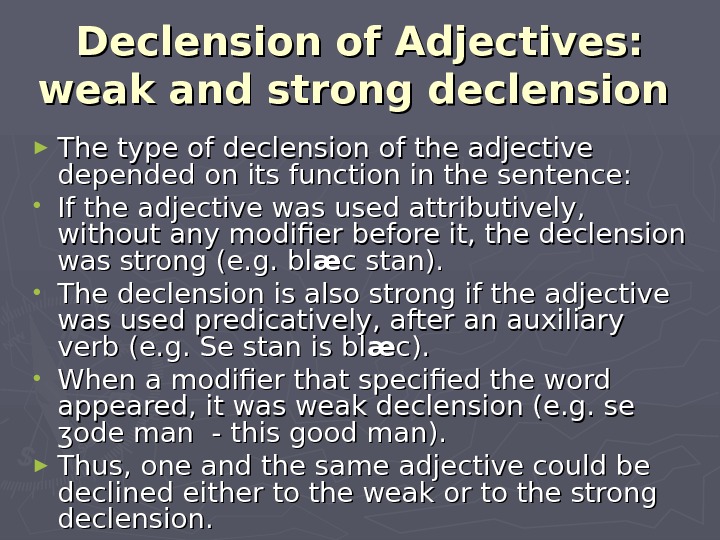
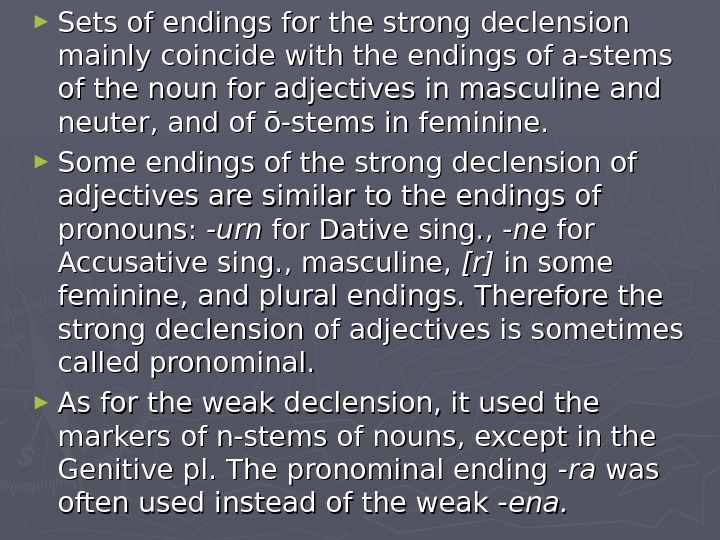
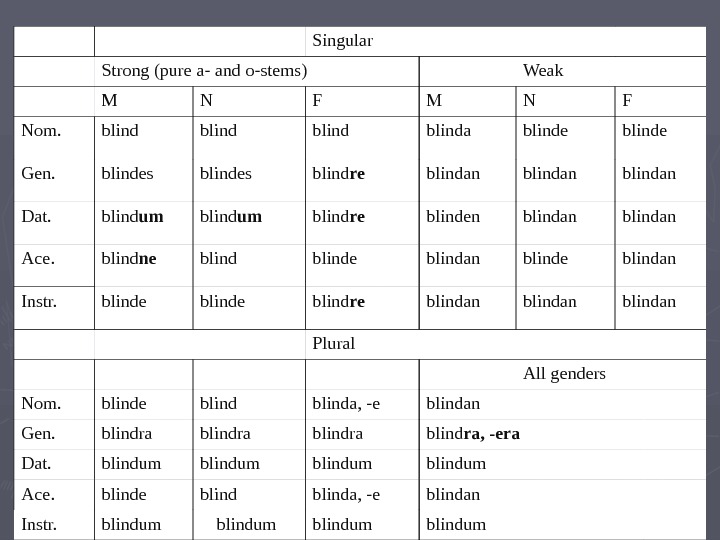

- Размер: 212.5 Кб
- Количество слайдов: 22
Описание презентации Old English Grammar General characteristics по слайдам
 Old English Grammar
Old English Grammar
 General characteristics ► аа synthetic language; ► grammatical means: • suffixation (grammatical endings, prefixes); • sound interchange in the root; • suppletive form-building; ► a highly inflected language
General characteristics ► аа synthetic language; ► grammatical means: • suffixation (grammatical endings, prefixes); • sound interchange in the root; • suppletive form-building; ► a highly inflected language
 Parts of speech in OE ► the noun, ► the adjective, ► the numeral, ► the pronoun, ► the verb, ► the adverb, ► the verbals (Infinitive and Participle I , II), ► the preposition, ► the conjunction, ► the interjection
Parts of speech in OE ► the noun, ► the adjective, ► the numeral, ► the pronoun, ► the verb, ► the adverb, ► the verbals (Infinitive and Participle I , II), ► the preposition, ► the conjunction, ► the interjection
 Grammatical categories ► Nominal (( the noun, the adjective, the pronoun and the numeral) ► Verbal Grammatical categories served for agreement between different parts of speech.
Grammatical categories ► Nominal (( the noun, the adjective, the pronoun and the numeral) ► Verbal Grammatical categories served for agreement between different parts of speech.
 OE Noun: Number; Gender; Case ► Number was expressed formally with all nouns. The typical plural endings were -es, -en, -ru. . By the end of the OE period these three endings came to the overall conformity and accepted the form -es (s). .
OE Noun: Number; Gender; Case ► Number was expressed formally with all nouns. The typical plural endings were -es, -en, -ru. . By the end of the OE period these three endings came to the overall conformity and accepted the form -es (s). .
 Gender: masculine, feminine, neuter ► Sometimes a suffix could refer a noun to a certain gender: • -þu-þu was a feminine suffix for abstract noun (lenʒþu — length, hyhþu — height ), ), • -ere was a masculine suffix showing the doer of the action (fiscere – NE fisher – learned man). ► Normally it was difficult to determine the gender by formal features. Gender distinction was not grammatical, but semantic — it was not expressed formally. Very often gender was controversial – the grammatical gender did not always coincide with the natural gender of the person: • the noun wifman (wife) was declined as masculine.
Gender: masculine, feminine, neuter ► Sometimes a suffix could refer a noun to a certain gender: • -þu-þu was a feminine suffix for abstract noun (lenʒþu — length, hyhþu — height ), ), • -ere was a masculine suffix showing the doer of the action (fiscere – NE fisher – learned man). ► Normally it was difficult to determine the gender by formal features. Gender distinction was not grammatical, but semantic — it was not expressed formally. Very often gender was controversial – the grammatical gender did not always coincide with the natural gender of the person: • the noun wifman (wife) was declined as masculine.
 ► One word could have different meanings with different genders: • se ar (masc. ) — a messenger. • seo ar (ferm. ) — an oar. • Þæt ar (neut. ) — ore, copper. ► These features of gender led to the early disappearance of this category in the process of simplification in the language and by the end of the OE period “he” or ‘she’ for inanimate objects were replaced by ‘it’.
► One word could have different meanings with different genders: • se ar (masc. ) — a messenger. • seo ar (ferm. ) — an oar. • Þæt ar (neut. ) — ore, copper. ► These features of gender led to the early disappearance of this category in the process of simplification in the language and by the end of the OE period “he” or ‘she’ for inanimate objects were replaced by ‘it’.
 Case ► Nominative case served as the subject, the predicate or the address. ► Genetive case expressed the idea of origin and the idea of possession. ► Dative was used with prepositions and it possessed instrumental meaning. ► Accusative case represented the direct object or showed time and distance; its form often fell together with the form of the Nominative case.
Case ► Nominative case served as the subject, the predicate or the address. ► Genetive case expressed the idea of origin and the idea of possession. ► Dative was used with prepositions and it possessed instrumental meaning. ► Accusative case represented the direct object or showed time and distance; its form often fell together with the form of the Nominative case.
 Declensions in OE ► 1) The vowel or ‘strong’ declension, which comprised four principal paradigms — the a-, o-, u-, i –stem paradigm. The paradigm is the set of all phones of of a word within one part of speech. .
Declensions in OE ► 1) The vowel or ‘strong’ declension, which comprised four principal paradigms — the a-, o-, u-, i –stem paradigm. The paradigm is the set of all phones of of a word within one part of speech. .
 ► 2) The consonant or “weak” declension (n — stems). ► 3) The declension of root-stem nouns. The set of case endings was predetermined by the type of declension. The OE Noun formed its paradigm by the opposition of three genders, two numbers and four cases. Thus, the Noun had 24 word-forms.
► 2) The consonant or “weak” declension (n — stems). ► 3) The declension of root-stem nouns. The set of case endings was predetermined by the type of declension. The OE Noun formed its paradigm by the opposition of three genders, two numbers and four cases. Thus, the Noun had 24 word-forms.
 Sing. A-stem Plur. N. Stan (stone) stanas G. stones stana D. stane stanum Ace. stān stanas Sing. N-stem Plur. N. Nama (name) naman G. naman namena D. noman namum Ace. naman Sing. Root-stem Plur. N. man men G. manes mana D. menn manum Ace. man men
Sing. A-stem Plur. N. Stan (stone) stanas G. stones stana D. stane stanum Ace. stān stanas Sing. N-stem Plur. N. Nama (name) naman G. naman namena D. noman namum Ace. naman Sing. Root-stem Plur. N. man men G. manes mana D. menn manum Ace. man men
 the Numeral: number quantity ► Cardinal number is a numeral expressing the number as a quantity. They are of IE origin and have parallels in other IE languages. • 1. ān 2. twējen (twā) 3. þrio (tyn) 4. feower. 5 fif 6. syx (siex) 7. seofon 8. eahte 9. nijon 10. tien. 11. endleofan 12. twelf 13. þreotine
the Numeral: number quantity ► Cardinal number is a numeral expressing the number as a quantity. They are of IE origin and have parallels in other IE languages. • 1. ān 2. twējen (twā) 3. þrio (tyn) 4. feower. 5 fif 6. syx (siex) 7. seofon 8. eahte 9. nijon 10. tien. 11. endleofan 12. twelf 13. þreotine
 ► Numerals 13 -19 were formed by adding the suffix – tine/tiene to corresponding numerals among the first ten. ► The suffix -tiʒ was used to form numerals like 20, 30, 40 and so on. ► 70, 80, 90 took on prefix hund- (70 — hundseofontiʒ, 100 — hundteontiʒ) , 1000 -þusend. ► The first three cardinal numbers (an, tweʒen, þreo) had forms of gender and case, cardinal numbers 4 — 19 did not decline.
► Numerals 13 -19 were formed by adding the suffix – tine/tiene to corresponding numerals among the first ten. ► The suffix -tiʒ was used to form numerals like 20, 30, 40 and so on. ► 70, 80, 90 took on prefix hund- (70 — hundseofontiʒ, 100 — hundteontiʒ) , 1000 -þusend. ► The first three cardinal numbers (an, tweʒen, þreo) had forms of gender and case, cardinal numbers 4 — 19 did not decline.
 Ordinal number is a numeral expressing the order in account ► The first two ordinal numerals are formed by means of suppletion: one – first (fyrest), two — second (of Latin origin; the native corresponding form was oþer). ► 3. þridda 4. feowerþa 5. fifta 6. siexta 7. seofoþa 8. eahtoþa 9. nijoþa 10. teoþa 11. endlefta 12. twelfta ► Ordinal numerals 13 — 19 added suffix — teoþa; 20 — 120 — tijoþa and could be declined weak.
Ordinal number is a numeral expressing the order in account ► The first two ordinal numerals are formed by means of suppletion: one – first (fyrest), two — second (of Latin origin; the native corresponding form was oþer). ► 3. þridda 4. feowerþa 5. fifta 6. siexta 7. seofoþa 8. eahtoþa 9. nijoþa 10. teoþa 11. endlefta 12. twelfta ► Ordinal numerals 13 — 19 added suffix — teoþa; 20 — 120 — tijoþa and could be declined weak.
 Adjective — grammatical categories: ► case, ► number, ► gender, ► the category of degrees of comparison ► the category of definiteness/indefiniteness.
Adjective — grammatical categories: ► case, ► number, ► gender, ► the category of degrees of comparison ► the category of definiteness/indefiniteness.
 ► Adjectives agreed with nouns in number, gender and case. ► Like nouns, adjectives had three genders and two numbers. ► the category of case differed from that of nouns: they had one more case, Instrumental. It was used when the adjective served as an attribute to a noun in the Dative case, expressing an instrumental meaning.
► Adjectives agreed with nouns in number, gender and case. ► Like nouns, adjectives had three genders and two numbers. ► the category of case differed from that of nouns: they had one more case, Instrumental. It was used when the adjective served as an attribute to a noun in the Dative case, expressing an instrumental meaning.
 ► The category of definiteness/indefiniteness: • any indefinite adjective referred to new, previously unknown nouns, • any definite one described particular, already known nouns. Later the function of this category as delegated to the new part of speech — the article.
► The category of definiteness/indefiniteness: • any indefinite adjective referred to new, previously unknown nouns, • any definite one described particular, already known nouns. Later the function of this category as delegated to the new part of speech — the article.
 ► Like today, in OE there existed typical endings of the adjective: • -iʒ = ig; (e. g. halig — holy; mistig — misty); • -lic; (e. g. eorþlic — earthly); • -en/in; (e. g. gylden — golden; wyllen — woolen); • -isc; (e. g. Englisc — English), This ending was mainly used with nationalities. • -full; (e. g. sorgfull -sorrowful); • -sum; (e. g, halsum — wholesome); æ æ þelinʒʒ • -leas; (e. g. sl ææ pleas -sleepless); • -weard; (e. g. hamweard — homeward); • -feald; (e. g. þriefeald -threefold); • -ihte; (e. g. þirnihte — thorny); • -ede; (e. g. micelheafdede — large-headed).
► Like today, in OE there existed typical endings of the adjective: • -iʒ = ig; (e. g. halig — holy; mistig — misty); • -lic; (e. g. eorþlic — earthly); • -en/in; (e. g. gylden — golden; wyllen — woolen); • -isc; (e. g. Englisc — English), This ending was mainly used with nationalities. • -full; (e. g. sorgfull -sorrowful); • -sum; (e. g, halsum — wholesome); æ æ þelinʒʒ • -leas; (e. g. sl ææ pleas -sleepless); • -weard; (e. g. hamweard — homeward); • -feald; (e. g. þriefeald -threefold); • -ihte; (e. g. þirnihte — thorny); • -ede; (e. g. micelheafdede — large-headed).
 Declension of Adjectives: weak and strong declension ► The type of declension of the adjective depended on its function in the sentence: • If the adjective was used attributively, without any modifier before it, the declension was strong (e. g. bl ææ c stan). • The declension is also strong if the adjective was used predicatively, after an auxiliary verb (e. g. Se stan is bl ææ c). • When a modifier that specified the word appeared, it was weak declension (e. g. se ʒode man — this good man). ► Thus, one and the same adjective could be declined either to the weak or to the strong declension.
Declension of Adjectives: weak and strong declension ► The type of declension of the adjective depended on its function in the sentence: • If the adjective was used attributively, without any modifier before it, the declension was strong (e. g. bl ææ c stan). • The declension is also strong if the adjective was used predicatively, after an auxiliary verb (e. g. Se stan is bl ææ c). • When a modifier that specified the word appeared, it was weak declension (e. g. se ʒode man — this good man). ► Thus, one and the same adjective could be declined either to the weak or to the strong declension.
 ► Sets of endings for the strong declension mainly coincide with the endings of a-stems of the noun for adjectives in masculine and neuter, and of ō-stems in feminine. ► Some endings of the strong declension of adjectives are similar to the endings of pronouns: -urn for Dative sing. , — nene for Accusative sing. , masculine, [r][r] in some feminine, and plural endings. Therefore the strong declension of adjectives is sometimes called pronominal. ► As for the weak declension, it used the markers of n-stems of nouns, except in the Genitive pl. The pronominal ending -ra-ra was often used instead of the weak — ena.
► Sets of endings for the strong declension mainly coincide with the endings of a-stems of the noun for adjectives in masculine and neuter, and of ō-stems in feminine. ► Some endings of the strong declension of adjectives are similar to the endings of pronouns: -urn for Dative sing. , — nene for Accusative sing. , masculine, [r][r] in some feminine, and plural endings. Therefore the strong declension of adjectives is sometimes called pronominal. ► As for the weak declension, it used the markers of n-stems of nouns, except in the Genitive pl. The pronominal ending -ra-ra was often used instead of the weak — ena.
 Singular Strong (pure a- and o-stems) Weak M N F Nom. blinda blinde Gen. blindes blind re blindan Dat. blind um blind re blinden blindan Ace. blind ne blinde blindan Instr. blinde blind re blindan Plural All genders Nom. blinde blinda, -e blindan Gen. blindra blind ra, -era Dat. blindum Ace. blinde blinda, -e blindan Instr. blindum
Singular Strong (pure a- and o-stems) Weak M N F Nom. blinda blinde Gen. blindes blind re blindan Dat. blind um blind re blinden blindan Ace. blind ne blinde blindan Instr. blinde blind re blindan Plural All genders Nom. blinde blinda, -e blindan Gen. blindra blind ra, -era Dat. blindum Ace. blinde blinda, -e blindan Instr. blindum
 Category of Degrees of Comparison: positive, comparative and superlative. ► Suffixation: soft — softra — softest (soft) ► Suffixation plus vowel interchange: lonʒ — lenʒra — lenʒest (long) ► Suppletion: ʒod — bettra — betest (good)
Category of Degrees of Comparison: positive, comparative and superlative. ► Suffixation: soft — softra — softest (soft) ► Suffixation plus vowel interchange: lonʒ — lenʒra — lenʒest (long) ► Suppletion: ʒod — bettra — betest (good)
